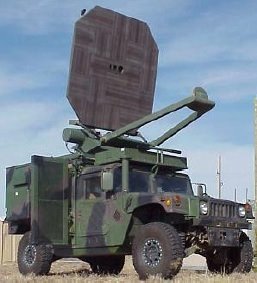Active Denial System? $13 million. Giving pesky peace protestors the hot foot? Priceless.
 I couldn't believe what I was seeing Sunday night. Was it 60 Minutes or an advertisement paid for by the Pentagon?
I couldn't believe what I was seeing Sunday night. Was it 60 Minutes or an advertisement paid for by the Pentagon?I've loved watching the venerable news program since I was a kid, and that's a long time. On Feb. 24, for example, the show did its usual bang-up job on a trio of stories: the politically-motivated bribery conviction of former Albama governor Don Siegelman, the killing of a black reporter who dared tell the truth about a corrupt local business, and the dire implications for all of us due to the disappearance of honey bees due to colony collapse disorder. Even when I don't agree with their approach, I love Morley Safer and Dan Rather and loved (the late) Ed Bradley. Hell, I even liked Diane Sawyer.
But this new guy, David Martin -- who has been the CBS Pentagon and national security correspondent since 1993 and has filed stories for 60 Minutes Wednesday, something I've never watched -- gave a breathless report on the Active Denial System, a non-lethal crowd control device that uses millimeter waves to create a burning sensation . Martin called it "The Ray Gun," and to demonstrate how effective the gadget was, Martin had himself repeatedly zapped by the thing. He writhed dramatically and cried out in pain. I used to hate this sort of thing when local television correspondents would volunteer to be hit with a Taser to show how safe they are (and it turns out they're not that safe). The angle of Martin's piece was that there's this wonderful new non-lethal gizmo that could be used in Iraq to save American lives, it has a range of half a mile, but the chowderheads in charge are refusing to embrace it because it isn't a lethal weapon. Fair enough. Problem is, what was presented as granted in the piece was that crowds (and by association, the right to free speech) must be controlled as a matter of national security.
My disbelief turned to anger when the device was aimed (in a test formulated by the military) at a group of soldiers pretending to be protestors. They were dressed in jeans and hoodies and carried badly-letter signs with slogans which called for world peace. What was implied, of course, is that peace activists are the enemy. They were rowdy, and some of them were throwing rocks at the vehicle upon which the ADS is mounted. Now, was it really necessary that any slogans be written on the signs for an effective demonstration? Blank signs would serve just as well. But then, the Pentagon would be denied the opportunity to slyly get their message across -- a message that was just as wrong in 1968 as in 2008, that "peace now" is code for anti-American. To be ethical, Martin should have declined to participate in, or use the video from, the military-controlled test. At the least, he should have asked those in charge why the enemy was portrayed as peace activists. But no, he couldn't stop gushing about the Pentagon's new toy.
Worse, Martin asked nary a question about whether this device would ever be used to disperse American crowds. Instead, he portrayed it as a way to read the minds of a crowd -- if anybody stays put after being stung with this thing, then they must be an imminent threat and subject to elimination by lethal force. What? If it won't really stop somebody intent on doing damage, then what the hell good is it? Well, it's good for stopping demonstrations and ending free speech, period, and if somebody struggles to keep that right, then they deserve to get shot. The police state isn't coming, it's here, because the news program I have trusted most to bring me the truth is now shilling for the Pentagon. The hard question here wasn't why the military hasn't deployed this thing in Iraq; the hard question is when the government intends to deploy it here.
It reminds me of William L. "Atomic Bill" Lawrence, a NYT reporter who was tapped to become the official correspondent for the Manhattan project. Lawrence, who won a couple of Pulitzers, earnestly (and wrongly) defended the military position that those who survived the bombings of Hiroshima and Nagasaki weren't really suffering any radiation sickness, it was just a ploy to drum up sympathy. It took a rebellious Austrailian journalist, Wilfred Burchett, to violate military orders and venture into ground zero to see for himself the radiation sickness, which he dubbed the "atomic plague." It makes me admire Austrailians more and value Pulitzers less.
Martin has been covering the Pentagon far too long. He no longer sees himself as somebody on the outside, but one of the insiders who is spreading the good news. He didn't even accurately describe how the damn thing works (it uses 96-GHz radio waves to excite molecules just beneath the skin; it doesn't use light or lasers, as the term "ray gun" implies). Martin demonstrated how the waves could penetrate plywood and a mattress, but if he'd had a basic understanding of science he would have used metallic mesh instead. But then, a tinfoil hat would just have looked silly on television -- and it would have given the enemy, those dirty dirty hippies, ideas about how to thwart the gadget.
Martin should go back to Wednesday night -- or better yet, he should go back to local news, where he can be zapped with Tasers during sweeps week until he soils his pants. What was 60 Minutes thinking? Perhaps they were trying to steal some viewers from Fox. By the way, this piece was produced by Mary Walsh, who -- big surprise -- has worked with Martin since he was assigned to the Pentagon.


<< Home